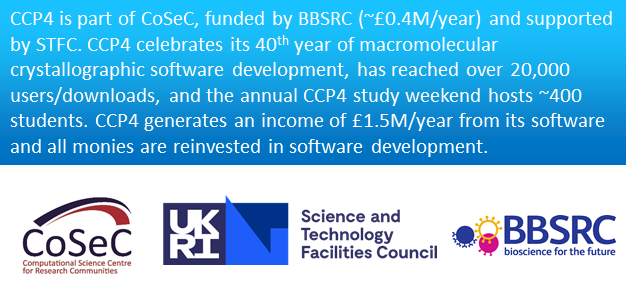 Enabling scientific research is part-and-parcel of the Collaborative Computational Projects' (CCPs) remit; to have enabled the provision of material that is recognized by the Royal Swedish Academy (that awards the Nobel Prize) warrants special mention for CCP4.
Enabling scientific research is part-and-parcel of the Collaborative Computational Projects' (CCPs) remit; to have enabled the provision of material that is recognized by the Royal Swedish Academy (that awards the Nobel Prize) warrants special mention for CCP4.
.png)
CCP4's crystallographic software applications were used to identify how the enzyme tryptophan synthase (5DW3) could be mutated to regain its catalytic activity outside its native cell environment. 5DW3 catalyses many useful reactions, relevant to the synthesis of pharmaceuticals, as well as industrial biosynthetic processes - often replacing environmentally
hazardous procedures.
Image of PDB ID 5DW3: Directed evolution of the tryptophan synthase beta-subunit for stand-alone function recapitulates allosteric activation. Buller, A.R., Brinkmann-Chen, S., Romney, D.K., Herger, M., Murciano-Calles, J., Arnold, F.H. (2015) Proc.Natl.Acad.Sci.USA 112: 14599-14604
Linus Pauling Professor of Chemical Engineering, Bioengineering and Biochemistry at the California Institute of Technology (Caltech), Frances Arnold, won the Nobel Prize in Chemistry in 2018 for her work on 'the directed evolution of enzymes'. Frances won half of the award, the other half was won jointly by George P. Smith (University of Missouri, Columbia) and Sir Gregory Winter (MRC Laboratory of Molecular Biology, Cambridge) for their work on '..the phage display of peptides and antibodies'. Professor Arnold was recognised by the academy for her novel approach to engineering proteins using a method she has been developing since 1993. The academy stated '..she conducted the first directed evolution of enzymes, which are proteins that catalyse chemical reactions. Since then, she has refined the methods that are now routinely used to develop new catalysts. The uses of Frances Arnold’s enzymes include more environmentally friendly manufacturing of chemical substances, such as pharmaceuticals, and the production of renewable fuels for a greener transport sector.”
While engineering proteins through their genetic code was the standard, Professor Arnold's inspired approach involves engineering proteins by mimicing evolution. Random mutations are introduced throughout the sequences of a large number of bacterial proteins. Bacteria are amenable to accelerated evolution thanks to their propensity to produce a new generation every twenty minutes. The 'best' mutations are selected and are used to repeat the process. The definition of 'best' depends on the characteristics sought and how these can be measured, including for example, the crystal structure of the proteins that can provide information about its stability, from which it is possible to understand how to engineer the protein to ensure it survives outside its familiar environment i.e. outside a cell..
This is where CCP4 and several of its applications played a contributory role: by providing X-ray crystallographic studies of proteins, see for example this leading paper that was cited in the supporting background report. The same paper also cites another led by SCD's Martyn Winn.
CCP4 and its software applications have gained visibility across the Atlantic thanks to initiatives described by Ronan Keegan (one of the CCP4 core team of software developers) : " We have been actively promoting the
CCP4 software in the USA through our educational outreach
programme, staging an annual summer school in Chicago. It's great to see
researchers based there using CCP4 for this ground breaking research.“
From a personal perspective, a career in fundamental research and development can lead to a disconnect between day-to-day work done at the microscopic scale and any impact it might have at the macroscopic scale. Yet, here is a prime and current example. Take heart researchers everywhere, at every (time- and length-) scale!

This text is based on articles written by Marion
O’Sullivan : https://www.scd.stfc.ac.uk/Pages/Nobel-Prize-for-Chemistry-2018.aspx and Liz Fuller-Wright : https://www.princeton.edu/news/2018/10/03/princeton-engineering-alumna-frances-arnold-wins-nobel-prize-chemistry
